Municipal Solid Waste Factsheet
Municipal Solid Waste (MSW), commonly called “trash” or “garbage,” includes wastes such as durable goods (e.g., tires, furniture), nondurable goods (e.g., newspapers, plastic plates/cups), containers and packaging (e.g., milk cartons, plastic wrap), and other wastes (e.g., yard waste, food). This category of waste generally refers to common household waste, as well as office and retail wastes, but excludes industrial, hazardous, and construction wastes. The handling and disposal of MSW is a growing concern as the volume of waste generated in the U.S. continues to increase.1
U.S. MSW Composition, 20181
Image
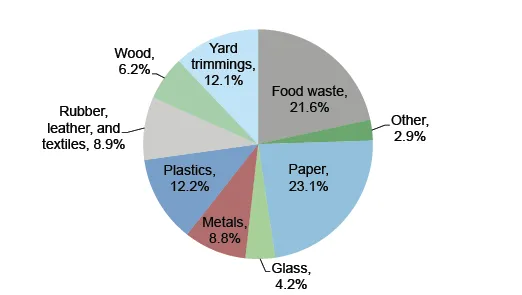
U.S. Annual MSW Generation1
Image
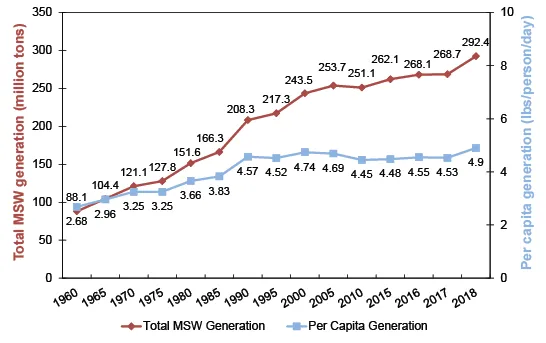
Generation Statistics
- Total annual MSW generation in the U.S. has increased by 93% since 1980, to 292 million U.S. short tons (tons) per year in 2018.1
- Per capita MSW generation increased by 34% over the same time period, from 3.7 to 4.9 pounds per person per day.1 For comparison, MSW generation rates (in lbs/person/day) are 2.5 in Sweden, 3.9 in Germany, and 2.8 in the United Kingdom.2 At the 2018 per capita rate, an American weighing 180 pounds generates their own weight in MSW every 37 days.
- In 2021, per capita generation of MSW was 29 pounds per $1,000 of GDP in the U.S., 18 in Sweden, 23 in the UK, and 29 in Germany.3,4
- Packaging, containers, and durable goods made up 48% of MSW generation in 2018. Most of the remainder was split between nondurable goods, food waste, and yard waste.1
Management Methods
Landfill
- • In 2018, 50% of MSW generated in the U.S. was disposed of in 1,278 landfills.1,5
- The 2022 combined capacity of the two largest landfill corporations in the U.S. was 10.3 billion cubic yards.6
- Landfill disposal (“tipping”) fees in 2020 in the U.S. averaged $53.72 per ton, a 3% decrease from 2019.7 These fees are used as funding for operation and maintenance of landfills, but there is still a lack of funding for research and technologies for waste diversion.8
- Environmental impacts of landfill disposal include loss of land area, emissions of methane (CH₄, a greenhouse gas) to the atmosphere, and potential leaching of hazardous materials to groundwater, though proper design reduces this possibility.9,10
- Landfills were the third largest source of U.S. anthropogenic CH4 emissions in 2021, accounting for 122.6 million metric tons (Mt) CO2e emissions, about 1.9% of total GHG emissions.9
MSW Management in the U.S.1
Image
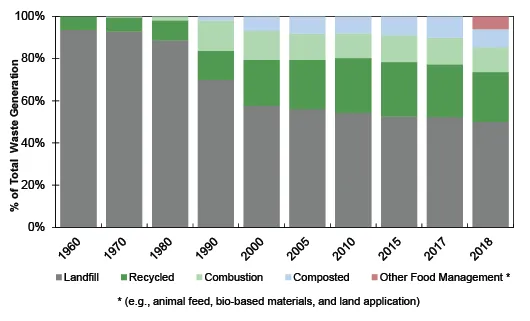
Combustion
- In 2018, 11.8% of MSW generated in the U.S. was disposed of through waste incineration with energy recovery.1
- Combustion reduces waste 75-85% by weight and 85-95% by volume, leaving behind a residue called ash. A majority of this ash is landfilled, although recent attempts have been made to reuse the residue.12 In 2021, 64 power plants burned 28 million tons of MSW and generated about 13.6 billion kWh of electricity.13
- Biogenic MSW (paper, food, and yard waste) accounted for 45% (6.12 billion kWh) of the electricity produced, or about 0.15% of total U.S. electricity generation.13,14
- Incineration of MSW generates a variety of pollutants (CO₂, heavy metals, dioxins, particulates) that contribute to impacts such as climate change, smog, acidification, and human health impacts (asthma and heart and nervous system damage).15
Regional MSW Management, 201011
Image
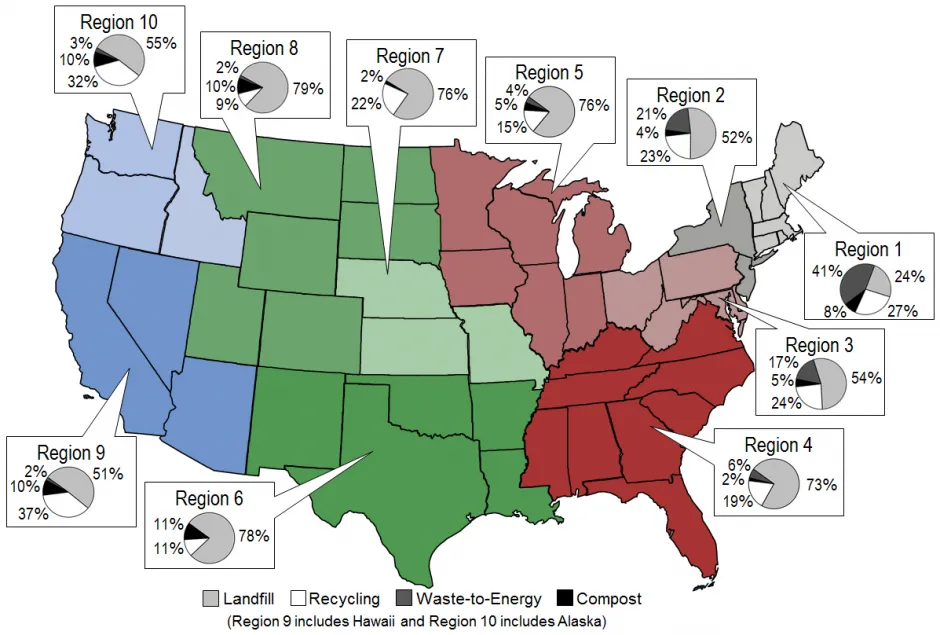
Recycling and Composting
- In 2018, 32.1% of MSW (by weight) generated in the U.S. was recovered for recycling or composting, diverting 93.9 million tons of material from landfills and incinerators—about 2.8 times the amount diverted in 1990.1
- In 2018, 27% of recovered MSW was composted.1
- Only 53% of people in the U.S. live in communities that automatically provide curbside recycling services; 82% of cities with curbside recycling collect material single-stream, meaning materials such as glass and paper are separated at the recycling plant.16,17 The number of curbside programs in the U.S. has increased more than ninefold since 1988.18,19
- In 2018, 97% of corrugated boxes were recovered for recycling in 2018; other highly recycled products include lead-acid batteries (99%), newspapers (65%), major appliances (60%), and aluminum beverage cans (50%).1
- Common products with poor recycling rates include: carpet (9%), small appliances (6%), and furniture (0.3%).20
Recovery of Materials in MSW, 20181
Image
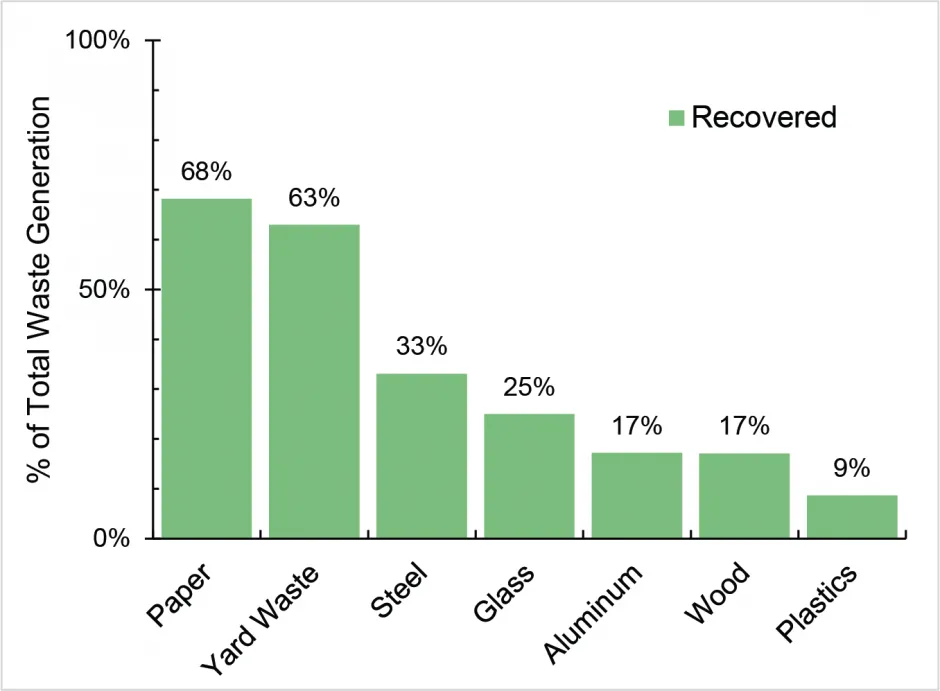
Solutions and Sustainable Alternatives
Source Reduction
- Source reduction activities help prevent materials from entering the MSW stream and are the most effective way to reduce waste generation.21
- Identify opportunities to reuse materials at home or in your community. Purchase items like furniture and appliances from reuse centers and consignment shops.
- Packaging and containers made up 28% of the MSW generated in 2018. Minimize the volume of packaging material required by selecting efficiently packaged products or buying in bulk.1
- Purchase products with post-consumer recycled content and encourage companies to implement source reduction programs.
- In 2018, 2.5 million tons of paper and plastic plates and cups were disposed.20 Choose reusable plates, cups, and silverware over disposable goods and reuse them to make up for for their greater production burdens compared to disposables.22
- Food waste makes up 24% of MSW in the U.S., more than any other material. Yet only 5% is recovered or composted. Reduce food waste through meal planning and composting of scraps.23
Encourage Supportive Public Policy
- Many communities have implemented Pay-As-You-Throw programs, designed to limit the volume of MSW per household by charging residents for waste collection based on the weight they throw away.24
- In 2020, the U.S. Department of Agriculture, Environmental Protection Agency and Food and Drug Administration renewed the Winning on Reducing Food Waste initiative, to continue to promote the reduction of food loss and waste.25
- In 2021, 25 states introduced food waste-related legislation to reduce the amount of food waste going to landfills.23
- Implementation of curbside recycling and composting programs can help reduce the burden of waste disposal.
- Although most states restrict landfill disposal of certain materials, some states do not restrict the disposal of potentially hazardous items (e.g., oil, batteries, tires, and electronics).26
- Ten states (CA, CT, HI, IA, ME, MA, MI, NY, OR, and VT) have deposit laws to encourage the return of empty beverage containers.27
- In June 2021, the U.S. House of Representatives held a hearing to discuss plastic waste reduction and recycling research. The Plastic Waste Reduction and Recycling Research Act was also considered for the role it could play in support of increasing federal investments in plastic waste reduction, recycling R&D, and recycling standards development.28
Cite As
Center for Sustainable Systems, University of Michigan. 2023. "Municipal Solid Waste Factsheet." Pub. No. CSS04-15.
References
- U.S. Environmental Protection Agency (EPA) (2020) Advancing Sustainable Materials Management: 2018 Fact Sheet.
- Organization for Economic Cooperation and Development (OECD) (2023) Municipal Waste Indicator.
- OECD (2021) Municipal Waste, Generation and Treatment.
- OECD (2023) Gross Domestic Product (GDP).
- U.S. EPA (2021) “Landfill Technical Data.”
- U.S. Securities and Exchange Commission (2023) Annual 10-K Filings.
- Waste Today (2021) “EREF releases analysis on national landfill tipping fees for 2020.”
- American Society of Civil Engineers (2021) 2021 Report Card for America’s Infrastructure, Solid Waste.
- U.S. EPA (2023) Inventory of U.S. Greenhouse Gas Emissions and Sinks 1990-2021.
- Andrews, W., et al. (2012) “Emerging contaminants at a closed and an operating landfill in Oklahoma.” Ground Water Monitoring & Remediation, 32(1): 120-130.
- The Journal for Municipal Solid Waste Professionals (2015) November/December 2015 MSW Management.
- U.S. EPA (2019) “Energy Recovery from the Combustion of Municipal Solid Waste (MSW).”
- U.S. Energy Information Administration (EIA) (2022) Waste-to-Energy (Municipal Solid Waste).
- U.S. EIA (2023) Monthly Energy Review April 2023.
- U.S. EPA (2016) “Air Emissions from MSW Combustion Facilities.”
- The Recycling Partnership (2020) 2020 State of Curbside Recycling Report.
- The Recycling Partnership (2017) The 2016 State of Curbside Report.
- U.S. EPA (2015) Advancing Sustainable Materials Management: Tables and Figures 2013.
- Biocycle (2006) “The State of Garbage in America.”
- U.S. EPA (2020) Advancing Sustainable Materials Management: 2018 Data Tables
- U.S. EPA (2015) “Reducing and Reusing Basics.”
- Miller, Shelie (2020) Five Misperceptions Surrounding the Environmental Impacts of Single-Use Plastic.
- U.S. Environmental Protection Agency (EPA) (2023) 2019 Wasted Food Report.
- U.S. EPA (2012) “Conservation Tools: Pay-As-You-Throw.”
- U.S. Department of Agriculture (2021) “Winning on Reducing Food Waste.”
- Northeast Recycling Council (2020) Disposal Bans and Mandatory Recycling in the United States.
- National Conference of State Legislatures (2020) State Beverage Container Deposit Laws.
- U.S. House of Representatives, Subcommittee on Research & Technology (2021) Hearing: Plastic Waste Reduction and Recycling Research: Moving from Staggering Statistics to Sustainable Systems, Hearing Charter.

